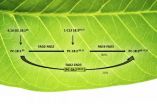(Press-News.org) UPTON, NY-Plant scientists at the U.S. Department of Energy's Brookhaven National Laboratory have found that certain enzymes responsible for desaturating fatty acids, the building blocks of oils, can link up to efficiently pass intermediate products from one enzyme to another. "Engineering these enzyme interactions to channel metabolites along desired metabolic pathways could be a new approach for tailoring plants to produce useful products," said Brookhaven biochemist John Shanklin, lead author on a paper reporting the results in the Journal of Biological Chemistry.
Getting plants to accumulate high levels of more healthful polyunsaturated fatty acids, or unusual fatty acids that could be used as raw materials in place of petroleum-derived chemicals in industrial processes, are a few possible outcomes.
Metabolic channeling
The idea would be to take advantage of a process called metabolic channeling, wherein enzymes that act sequentially in a particular metabolic pathway interact with each other so that they are able to pass molecules to each other without them entering the general metabolite pool of the cell. This close arrangement of enzymes also prevents intermediates from entering the metabolic channel.
Previous studies by Shanklin's group had shown that a distinct kind of desaturase enzyme that floats freely in plant plastids-mini plant cell "organs" where many metabolic processes, including photosynthesis, take place-pair up with themselves to form structures called dimers. The group had also studied baker's yeast and determined that its membrane-bound desaturase formed dimers too. But no studies had looked for these kinds of macromolecular arrangements in membrane-bound desaturases, called FADs, in higher plants. The current study used a molecular-genetic approach to explore the organization of membrane desaturases found in the plastids and endoplasmic reticulum (another membrane structure inside cells) of Arabidopsis, a common experimental plant.
Ying Lou, a postdoctoral research fellow working in Shanklin's lab, used several independent methods of bi-molecular complementation-methods that produce a signal if two test proteins come together-to establish which desaturases interact with themselves or others.
The scientists found that all the plant membrane desaturases they examined are capable of forming self-associating dimers in plant cells-pairings of two identical desaturase enzyme molecules. They also found that certain desaturases with different functions could also pair up, but others could not.
"The naturally pairing enzymes turn out to have interesting patterns," Shanklin said. "They are found in the same subcellular locations within the cell, and are involved in subsequent steps of the same metabolic pathway, suggesting a physiological driver for the observed pairings.
"Other pairings between very similar desaturases from different locations that we expected to pair up didn't," he added.
To test the idea that the paired enzymes were working together, the scientists conducted another series of experiments called metabolic flux analysis, drawing on Brookhaven biochemist Jorg Schwender's expertise. This method follows mass-labeled compounds through the various reaction pathways.
"Think of a city map with lots of ways to get from A to B. This method traces how many molecules travel along each route," Schwender said.
The analysis showed that one of the natural enzyme pairings performed two steps of a particular metabolic process without releasing an intermediate product.
"This was clear evidence that these two linked enzymes were working in concert to channel metabolites through this metabolic pathway in an efficient manner in living plant cells," Shanklin said. "Our findings suggest genetic techniques may be used to engineer these kinds of interactions into other desaturase enzymes-including enzymes that don't associate naturally-to push metabolites along desired pathways to produce useful products."
INFORMATION:
This research was funded by the DOE Office of Science.
DOE's Office of Science is the single largest supporter of basic research in the physical sciences in the United States, and is working to address some of the most pressing challenges of our time. For more information, please visit science.energy.gov.
One of ten national laboratories overseen and primarily funded by the Office of Science of the U.S. Department of Energy (DOE), Brookhaven National Laboratory conducts research in the physical, biomedical, and environmental sciences, as well as in energy technologies and national security. Brookhaven Lab also builds and operates major scientific facilities available to university, industry and government researchers. Brookhaven is operated and managed for DOE's Office of Science by Brookhaven Science Associates, a limited-liability company founded by the Research Foundation for the State University of New York on behalf of Stony Brook University, the largest academic user of Laboratory facilities, and Battelle, a nonprofit applied science and technology organization.
Related Links
Scientific paper: "FAD2 and FAD3 Desaturases Form Hetero-dimers That Facilitate Metabolic Channeling in vivo" http://www.jbc.org/content/early/2014/05/08/jbc.M114.572883
Plants' oil-desaturating enzymes pair up to channel metabolites
Study raises possibility of linking up enzymes to tailor pathways for increased production of useful plant products
2014-05-09
ELSE PRESS RELEASES FROM THIS DATE:
Leadless pacemaker showing promising results after 1 year
2014-05-09
Vivek Reddy, MD, Director of Arrhythmia Services for The Mount Sinai Hospital, reported his promising12-month follow-up data showing the world's first leadless pacemaker is demonstrating overall device performance comparable to conventional pacemakers. Dr. Reddy presented the one-year LEADLESS study data findings during his late-breaking clinical trial presentation on May 9 at Heart Rhythm 2014, the Heart Rhythm Society's 35th Annual Scientific Sessions in San Francisco, CA.
The LEADLESS study's long-term follow-up has evaluated 32 patients with a slowed heartbeat, bradycardia, ...
Scientists decode epigenetic mechanisms distinguishing stem cell function and blood cancer
2014-05-09
Researchers at Dartmouth's Norris Cotton Cancer Center have published results from a study in Cell Reports that discovers a new mechanism that distinguishes normal blood stem cells from blood cancers.
"These findings constitute a significant advance toward the goal of killing leukemia cells without harming the body's normal blood stem cells which are often damaged by chemotherapy," said Patricia Ernst, PhD, co-director of the Cancer Mechanisms Program of the Norris Cotton Cancer Center and an associate professor in Genetics at the Geisel School of Medicine.
The study ...
Study identifies mechanism by which intestinal enzyme maintains microbial balance
2014-05-09
Massachusetts General Hospital (MGH) investigators have identified the mechanism by which an enzyme produced in the intestinal lining helps to maintain a healthy population of gastrointestinal microbes. In their report in American Journal of Physiology – Gastrointestinal and Liver Physiology, the research team describes finding that intestinal alkaline phosphatase (IAP) promotes the growth of beneficial bacteria by blocking the growth-inhibiting action of adenosine triphosphate (ATP) – an action first described in this paper – within the intestine.
"We found that ATP ...
NASA sees system 90E just after earthquake hit Mexico's Guerrero State
2014-05-09
VIDEO:
This movie of imagery from NOAA's GOES-West satellite from May 7 at 14:15 UTC to May 9 at 14:15 UTC shows System 90E's progression and movement on land in southwestern...
Click here for more information.
As the dissipating tropical low pressure system known as System 90E continued rain on Guerrero State in southern Mexico, the U.S. Geological Survey reported a 6.4 magnitude earthquake occurred there on Thursday, May 8 around noon local time (1 p.m. EDT). NASA's Aqua satellite ...
Bioprinting a 3D liver-like device to detoxify the blood
2014-05-09
Nanoengineers at the University of California, San Diego have developed a 3D-printed device inspired by the liver to remove dangerous toxins from the blood. The device, which is designed to be used outside the body -- much like dialysis – uses nanoparticles to trap pore-forming toxins that can damage cellular membranes and are a key factor in illnesses that result from animal bites and stings, and bacterial infections. Their findings were published May 8 in the journal Nature Communications.
Nanoparticles have already been shown to be effective at neutralizing pore-forming ...
Rotational X-ray tracking uncovers hidden motion at the nanoscale
2014-05-09
Over the past two decades or so, there has been increasing interest and development in
measuring slow dynamics in disordered systems at the nanoscale, brought about in part from a demand for advancements in the food and consumer products industries.
Some of the techniques that have been developed over recent years to study the dynamic properties of these materials include X-ray photon correlation spectroscopy (XPCS) and speckle visibility spectroscopy (SVS). Both of these techniques however suffer from some fundamental limitations ranging from the use of only specialized ...
Study predicts adult obesity prevalence in almost all European countries by 2030
2014-05-09
Amsterdam, 9 May. Rates of obesity and overweight in both male and females are projected to increase in almost all countries of Europe by 2030, according to a statistical modelling study. However, the forecast rates vary throughout the 53 Euro-region countries, with projected male obesity levels ranging from 15% in the Netherlands and Belgium, to 47% in Ireland. The highest obesity prevalence in females was projected in Ireland (47%), and the lowest in Romania (10%).
The study, from investigators which included the WHO Regional Office for Europe, was presented at the ...
Colonization of Brazil by the cattle egret
2014-05-09
In recent years the cattle egret (Bubulcus ibis) has colonized American continent. Invasive species are a worldwide problem and studies are devoted to assess the damage they cause to local species populations. Thus, the process of colonization of a new territory that has continental dimensions such as Brazil offers an excellent opportunity to examine how non-native species disperse, adapt and survive. A new study of the colonization patterns of the cattle egret in Brazil, published in the open access journal NeoBiota, offers a new take on the study of alien species.
The ...
Research indicates coyote predation on deer in East manageable
2014-05-09
Coyotes are a major predator of white-tailed deer across the East, especially fawns born each spring, but wildlife managers nonetheless are able to stabilize and even grow deer herds, according to researchers in Penn State's College of Agricultural Sciences.
Coyotes -- Canis latrans -- are a relatively recent arrival to eastern North America, appearing first in the region in noticeable numbers in the 1970s. They are a significant source of deer mortality and most often prey on whitetails in the earliest months of their lives. Coyotes have long inhabited the American West.
With ...
Larger percentage of Texas Hispanics have enrolled in Health Insurance Marketplace plans
2014-05-09
HOUSTON – (May 9, 2014) – Texas Hispanics were more than twice as likely as whites to have enrolled in health insurance plans offered through the Affordable Care Act's Health Insurance Marketplace between September 2013 and March 2014, according to a report released today by Rice University's Baker Institute for Public Policy and the Episcopal Health Foundation.
The report also found that Hispanic adults in Texas experience more difficulty in affording health services than white adults and are three times as likely to be uninsured. In addition, Hispanic respondents ...
LAST 30 PRESS RELEASES:
Air pollution exposure and birth weight
Obstructive sleep apnea risk and mental health conditions among older adults
How talking slows eye movements behind the wheel
The Ceramic Society of Japan’s Oxoate Ceramics Research Association launches new international book project
Heart-brain connection: international study reveals the role of the vagus nerve in keeping the heart young
Researchers identify Rb1 as a predictive biomarker for a new therapeutic strategy in some breast cancers
Survey reveals ethical gaps slowing AI adoption in pediatric surgery
Stimulant ADHD medications work differently than thought
AI overestimates how smart people are, according to HSE economists
HSE researchers create genome-wide map of quadruplexes
Scientists boost cell "powerhouses" to burn more calories
Automatic label checking: The missing step in making reliable medical AI
Low daily alcohol intake linked to 50% heightened mouth cancer risk in India
American Meteorological Society announces Rick Spinrad as 2026 President-Elect
Biomass-based carbon capture spotlighted in newly released global climate webinar recording
Illuminating invisible nano pollutants: advanced bioimaging tracks the full journey of emerging nanoscale contaminants in living systems
How does age affect recovery from spinal cord injury?
Novel AI tool offers prognosis for patients with head and neck cancer
Fathers’ microplastic exposure tied to their children’s metabolic problems
Research validates laboratory model for studying high-grade serous ovarian cancer
SIR 2026 delivers transformative breakthroughs in minimally invasive medicine to improve patient care
Stem Cell Reports most downloaded papers of 2025 highlight the breadth and impact of stem cell research
Oxford-led study estimates NHS spends around 3% of its primary and secondary care budget on the health impacts of heat and cold in England
A researcher’s long quest leads to a smart composite breakthrough
Urban wild bees act as “microbial sensors” of city health.
New study finds where you live affects recovery after a hip fracture
Forecasting the impact of fully automated vehicle adoption on US road traffic injuries
Alcohol-related hospitalizations from 2016 to 2022
Semaglutide and hospitalizations in patients with obesity and established cardiovascular disease
Researchers ‘listen in’ to embryo-mother interactions during implantation using a culture system replicating the womb lining
[Press-News.org] Plants' oil-desaturating enzymes pair up to channel metabolitesStudy raises possibility of linking up enzymes to tailor pathways for increased production of useful plant products





